This review covers military events that took place on the territory of Belarus in August 2023.
The information is provided as of September 1, 2023.
Summary.
In August, the general activity of the Belarusian Armed Forces didn’t change significantly. A large number of combat training activities conducted by the Belarusian Armed Forces during the month were seasonal. We should note a large amount of information about rearmament and the supply of new models of military equipment to the troops.
The Russian component of the regional group of troops was completely withdrawn from the territory of Belarus. At the same time, there may still be about 2000 servicemen of the Russian Armed Forces in Belarus who are not formally part of the regional group of troops. In general, military activity of the Russian Armed Forces on the territory of Belarus has significantly decreased compared to winter-spring 2023. At the moment, there are no signs that this situation will change dramatically.
The prospects for the deployment of mercenaries of PMC Wagner in Belarus after the death of Yevgeny Prigozhin are still unclear. It is possible that the mercenaries’ activities in Belarus will completely end, as well as the structure will be transformed and its further activities will continue. In general, there is no data on significant activity of mercenaries in Belarus. Estimation of the number of mercenaries is currently complicated due to the lack of information.
The general medium-term forecast of the military situation in Belarus remains the same: there is no reason to expect an offensive operation of the Russian Armed Forces from the territory of Belarus. The key destabilizing factor is the deployment of mercenaries of PMC Wagner in Belarus.
1. Armed Forces of the Republic of Belarus
1.1. Organization of combat training.
August was traditionally full of combat training activities of the Belarusian Armed Forces. This is explained by the fact that during this period of time, field drills are conducted, during which units move from permanent deployment points to training grounds, where trainings and drills are conducted.
During the month, it was reported that field drills were conducted with artillery (1, 2), mechanized, reconnaissance, engineering (1, 2), repair, medical, air defense (1, 2) and electronic warfare units of the Belarusian Armed Forces. At the same time, a number of trainings were focused on preparations for the CSTO drills, which will be held in Belarus from September 1 to September 6.
Among the most significant combat training activities, we can distinguish the following:
1) From August 4 to August 14, combat training of the Belarusian Armed Forces was planned in Zhabinka district. Earlier, there was information about the construction of fortifications (stronghold) in the area of the training. No details about the training were revealed during the monitoring. The topic of the construction of fortified areas in the border areas of Belarus and the conduct of drills with the Belarusian Armed Forces in these areas requires further analysis and research.
2) From August 6 to August 11, servicemen of the 19th Separate Mechanized Brigade took part in tactical drills at the border commandant’s office of the Smarhon Border Guard Group. During the drills, the servicemen were on border guard duty. Involvement of mechanized units in strengthening border protection is a common practice.
3) Command staff drills with the 6th Separate Mechanized Brigade, which were held at the Hozhski training ground. During the drills, ambush and maneuver defense were practiced. While covering the drills, a number of media outlets stressed that they were held near the Suwalki gap. The Hozhski training ground is indeed located near the border with Lithuania, but it was built back in the 1950s and has been used by the military for a long time. We believe that there is no connection between the drills of the 6th Brigade and the potential threat to the Suwalki gap.
4) From August 14 to August 17, bilateral command staff drills with the 19th and 120th Separate Mechanized Brigades of the Northwestern Operational Command were held at the 227th combined arms training ground Barysauski. The topic was called “Management of military units in defensive combat.” Similar command staff drills with units of the Northwestern Operational Command were conducted in 2022.
5) Tactical special drills with reconnaissance forces of the Western Operational Command, which were held for three days in Hrodna and Brest regions. During the drills, reconnaissance of conditional enemy forces was practiced, UAVs and camera traps were actively used.
6) Soldiers of the 465th Missile Brigade underwent fire control training. Iskander-M missile systems and Tochka-U missile systems were involved in the training. Combat training tasks for preparing and launching missile strikes with both normal and special (nuclear) ammunition were practiced.
7) A group of servicemen of the 120th Separate Mechanized Brigade was sent to Russia to undergo a combat training course with instructors at one of the training centers in Russia. This is most likely the 333rd combat training center of the Western Military District of the Russian Armed Forces, where a joint combat training center of the Belarusian and Russian Armed Forces was established. Previously, soldiers of the 6th and 11th Separate Mechanized Brigades of the Belarusian Armed Forces were trained there.
As always, a lot of attention during drills is paid to countering sabotage and reconnaissance groups. Units of the Air Defense Forces actively practiced countering UAVs of a conditional enemy and tested new methods of organizing troops’ cover. Artillery units constantly and actively use UAVs for fire control. We should note that cadets begin to learn about the use of UAVs in the first year of study. Photo-reports from drills and trainings also show that elements of tactical medicine (tourniquet application to stop bleeding, evacuation of the wounded from the battlefield, etc.) are constantly practiced. In general, the use of the experience of the war in Ukraine in the organization of combat training is constantly declared.
A separate area of combat training is the use of units of the Belarusian Armed Forces to strengthen protection of the border with Ukraine. The official purpose of these activities is to ensure the safety of citizens, suppress violations of the state border, and eliminate channels for the supply of weapons and ammunition. At the same time, the analysis of the data of state procurement, as well as photo-reports of the Ministry of Defense of Belarus, allows us to state that units of the Belarusian Armed Forces are engaged not only in guarding the border with Ukraine, but also in providing security for the Russian military stationed at Mazyr (Bokau) and Ziabrauka airfields. The 103rd Airborne Brigade (Ziabrauka airfield), and probably the 5th Special Purpose Brigade (Mazyr (Bokau) airfield) of the Special Operations Forces of the Belarusian Armed Forces are involved in guarding the Russian military.
A separate area of combat training was the training of units of the Belarusian Armed Forces by mercenaries of PMC Wagner. It is known that the mercenaries conducted trainings in the 6th Separate Mechanized Brigade (Hozhski training ground) and the 51st Artillery Brigade (1, 2). It was also reported about joint drills of PMC Wagner and OMON.
The Telegram channel of the 51st Artillery Brigade covered the training with mercenaries the most. This can be explained by the proximity of the camp of PMC Wagner in Tsel village and Asipovichy, where the brigade is stationed. The trainings were conducted in two areas: artillery fire control and tactical training. In general, we must admit that the peak of coverage of trainings of Wagner mercenaries with units of the Belarusian Armed Forces and other law enforcement agencies was in the second half of July. In August, there were far fewer reports about trainings of mercenaries and the Belarusian Armed Forces.
We should also note a decrease in the number of reports about Wagner mercenaries sharing a “unique combat experience” with Lukashenko’s security forces in the state propaganda. The approach to the coverage of this topic can be characterized as wavy. After the arrival of the mercenaries in Belarus and the first trainings, propaganda resources published a lot of information on the topic. However, after a short period of time it ended. For example, the last mention of the training of PMC Wagner and the Belarusian Armed Forces in the Telegram channel of the Ministry of Defense of Belarus was published on July 30. Something similar could be observed in the work of propagandists after the arrival of the Russian contingent of the regional group of troops: the topic of the importance of the presence of the Russian military in Belarus quickly left the informational agenda, and the regional group of troops was completely forgotten. It is possible that propagandists received an order to reduce the presence of mercenaries in the informational space.
There were no reports on joint combat training activities of units of the Belarusian and Russian Armed Forces included in the regional group of troops.
No specifics of the organization and conduct of combat training of other security forces (Internal Troops, Border Guard Service) were observed.
1.2. Organization of training sessions with reservists.
During the month, it was reported about training sessions with reservists in the 11th Separate Mechanized Brigade (about 100 reservists), the 127th Signal Brigade (at least 25 reservists), the 288th Vehicle Reserve Base (at least 43 reservists), the 2657th Fuel Base (the number of reservists is unknown), and in Polatsk district (120 reservists). According to clarified information, about 150 conscripts took part in a training session held in July-August in the 841st Artillery Group of the 11th Separate Mechanized Brigade. It was reported that a training session was completed at the 969th Tank Reserve Base.
It was reported that military commisariats of Minsk, Brest, Mahiliou and Homiel regions sent reservists to military training sessions. In total, they sent at least 60 conscripts.
It was also reported about the selection of candidates for a military training session in the 2nd Militia Brigade of the Internal Troops. This means that the practice of holding training sessions with reservists of the Internal Troops will continue.
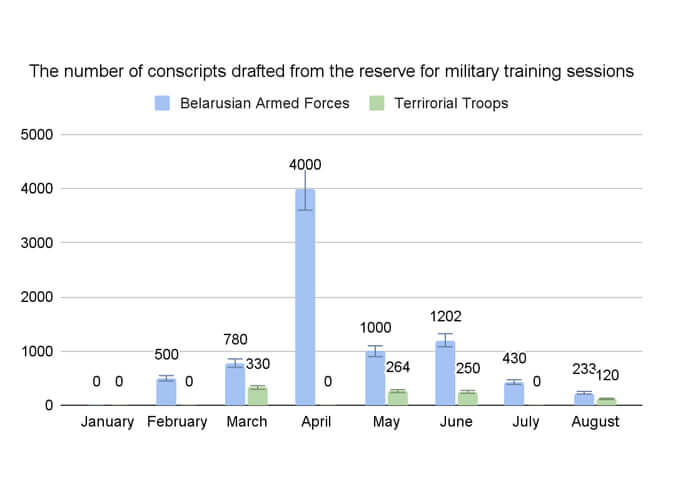
Thus, the total number of reservists drafted for training sessions in August can be estimated to be at least 353 people. In total, at least 9081 people have already been drafted for various types of training sessions from January to August 2023. Earlier, the Ministry of Defense of Belarus reported about its plans to draft 9000 people for training sessions in 2023. Thus, the limit on the draft of reservists for training sessions has already been exceeded.
We note that this is the lowest number of reservists, since we don’t know about all the military training sessions that have been held. Therefore, in reality, the number of reservists who have passed military training sessions is higher.
1.3. Movements of military equipment and aviation activity.
The intensity of movements of military equipment remained at the same level as in July. In general, there was nothing unusual in the movements of equipment of the Belarusian Armed Forces. More details on the movements of military equipment are available on the map of military activity.
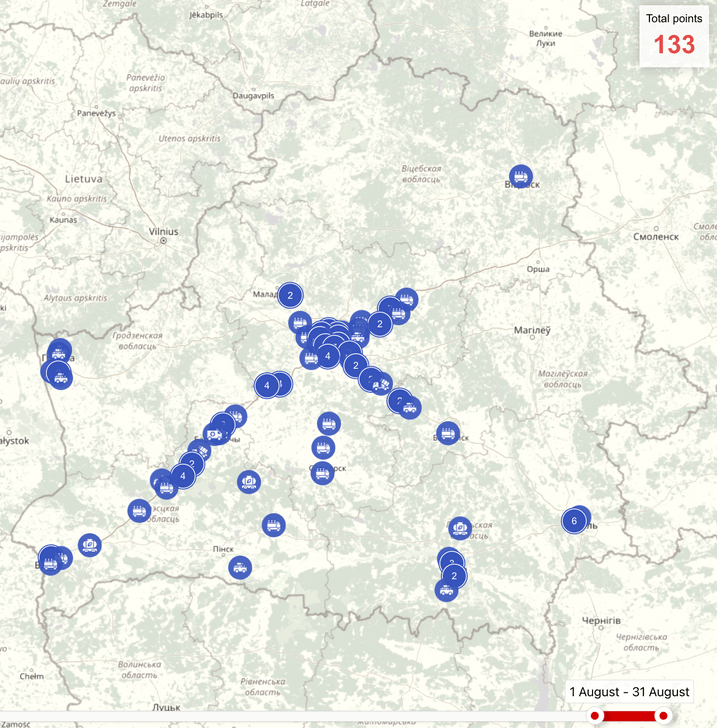
The intensity of movements of the Belarusian Armed Forces by rail increased compared to July. This is connected with the active conduct of field drills outside the permanent deployment points. As noted earlier, August is a usual time for such field trips.
The dynamics of movements by rail was affected by the redeployment of units of the 103rd Airborne Brigade to participate in the CSTO drills at the Brestski training ground, as well as by the rotation of units providing security at Ziabrauka airfield and the border with Ukraine. In general, movements of troops by rail are seasonal and situational.

The intensity of flights of the Belarusian Air Force increased compared to July. This may be connected with the air parade held on August 18, which was dedicated to Belarusian Air Force Day. Several major rehearsals were held as part of preparations for the parade.
Lida, Baranavichy, and Machulishchy airfields were mainly used for flights of the Belarusian Air Force. During the flights, the entire helicopter and aircraft fleet of the Belarusian Air Force was involved. In general, there was nothing unusual in the flights of the Belarusian Air Force.
We should also mention the incident when two Mi-8 and Mi-24 helicopters of the Belarusian Air Force flew into the territory of Poland. We note that the helicopters were in the border area with Poland to provide security for Aleksandr Lukashenko, who was at that moment in the Viskuli residence. Based on the available information, we can conclude that the helicopters could have entered the territory of Poland by accident.
The Ministry of Defense of Belarus denied the incident. At the same time, there is information that after the pilots of the helicopters involved in the incident returned to the airfield, they were met by representatives of security forces of the Lukashenko regime.
1.4. Territorial defense. National home guard.
Among the important events related to territorial defense, we can distinguish drills with reservists of the Territorial Troops, which are held from August 22 to September 14 in Polatsk district. During the drills, they will practice the recruitment of reservists, the restoration of practical skills, and the formation of the national home guard. The drills will end with the command staff drills with the territorial defense forces of the district.
We should note that the drills in Polatsk district will be the first in Vitsiebsk region in 2023. Since the beginning of the year, drills with territorial defense have already been held in eight districts of Minsk, Brest, Homiel, and Hrodna regions. About 850 reservists were drafted from the reserve for these drills.
In general, we can note the increased attention of the Lukashenko regime to the organization of territorial defense. One of the signs of it is the increasing number of drills with drafting reservists from the reserve.
Due to the adoption of the law “On the National home guard”, the processes for its formation began. For example, in the second half of August, military commissariats of Minsk region started to actively organize meetings and trainings with candidates for the national home guard (1, 2). Judging by the published photos, the future members studied the design of the Kalashnikov assault rifle, practiced disassembling and assembling it. They also studied the legal aspects of the national home guard’s activity.
We should note that the key issue related to the establishment of the national home guard, the procedure for issuing weapons and ammunition to the guards, has not yet been resolved. The normative act that should regulate these issues should be developed by the Ministry of Defense of Belarus.
1.5. Supplies of new military equipment to the troops.
In August, the Belarusian Armed Forces received the following military equipment:
1) A certain number of R-414MBRP Sosna radio relay stations. The complex is designed for organization of radio relay and cable communication lines, broadband radio access zones and DMR standard radio communication as part of field communication nodes, and for ensuring their connection, including to the public telecommunication network.
2) The first batch of four Mi-35M transport and attack helicopters. The contract for the delivery of the helicopters was signed in August 2020. In 2021, it was reported that the Belarusian Air Force would receive a squadron (12 helicopters) of Mi-35M. In February 2023, Commander of the Belarusian Air Force Andrei Lukyanovich said that the helicopters were to arrive in Belarus by early April 2023. As a result, the Belarusian Air Force received the helicopters five months later. It is unknown what the delay in the transfer of the helicopters is related to.
Mi-35M helicopters entered service with the 50th Combined Aviation Base of the Belarusian Air Force (military unit 06752, Machulishchy airfield). It was reported that by the end of 2023, Belarus will receive four more Mi-35M helicopters, and in 2024 – four more pieces. There are reasons to believe that the delivered helicopters may not be new. Today, the Mi-35M is the most modern helicopter in service with the Belarusian Air Force.
3) Another batch of Iskander-M missile systems arrived in Belarus. It was noted that this was not the last delivery of equipment for the Belarusian Armed Forces. The arrived batch consisted of 12 pieces of equipment, including at least four self-propelled launchers, transport loading vehicles and command staff vehicles. In early 2023, the Ministry of Defense of Belarus reported receiving the first batch of Iskander-M missile systems (at least two self-propelled launchers). According to open sources, a divizion of Iskander-M missile systems of the Russian Armed Forces consists of four self-propelled launchers. In turn, missile brigades of the Ground Forces of the Russian Armed Forces have three missile divizions each (12 self-propelled launchers in total). Thus, the Belarusian Armed Forces may already have a quantity of equipment that corresponds to 1.5 missile divizions of the Iskander-M missile system. It is possible that the Belarusian Armed Forces will eventually receive a brigade set of the Iskander-M missile systems. This was previously reported by propaganda resources. The complex entered service with the 465th Missile Brigade. Previously, the main armament of the brigade was the Tochka-U missile system. In this regard, we may assume that the 465th Missile Brigade may be fully rearmed with Iskander-M systems in the future. It is possible that the Tochka-U missile systems will also continue to be used until their technical resource is depleted.
The following supplies were also announced:
1) In service with the 231st Artillery Brigade – 301-mm V-200 Polonez MLRS. The brigade is part of the Northwestern Operational Command. So far, it has been armed with Uragan MLRS. Apparently, there are no plans to fully rearm the brigade’s rocket divizion with Polonez MLRS: the unit will be armed with both Polonez and Uragan MLRS. In the future, Polonez MLRS can be expected to enter service with the 111th Artillery Brigade of the Western Operational Command. The 231st Artillery Brigade will be the second unit of the Belarusian Armed Forces to be armed with Polonez MLRS. Previously, the systems were in service only with the 336th Rocket Artillery Brigade.
2) In service with the 740th Anti-Aircraft Missile Regiment of the Northwestern Operational Command – Osa-MA SAM system. During the field drills of the 740th Anti-Aircraft Missile Regiment, the modernized SAM system was studied. It was noted that the complex has improved characteristics, its survivability has been increased, its reconnaissance and firing capabilities have been improved, etc. There is no information about the Osa-MA SAM system in open sources.
We should also note that the Ministry of Defense of Belarus is planning to conduct major repairs of eight Su-25 attack aircraft in 2023. The aircraft are in service with the 116th Assault Air Base of the Belarusian Air Force (Lida airfield). We recall that in summer 2022, it was announced that Su-25 attack aircraft of the Belarusian Air Force would be re-equipped to use tactical nuclear weapons (TNW). And in April 2023, it was reported that the training of the Belarusian Air Force personnel in the use of nuclear warheads had been completed. It is unknown whether the planned repair of attack aircraft is related to their re-equipment for TNW use.
1.6. Amendments to the legislation in the military sphere.
A key change in the legislation in the military sphere was the adjustment of the procedure for military training sessions. On August 15, the resolution of the Council of Ministers No. 525 of August 10, 2023 was published, which amended the Regulation on the procedure for military and special training sessions. The changes affected the duration and frequency of military training, as well as the requirements for the health condition of reservists. The amendments allow for more frequent draft of reservists to military training sessions, holding certain types of training sessions longer, increasing the control over the training sessions by the KGB, involving those with limited fitness for military service in military training sessions, etc.
The characteristics fully correspond to the main trends of conduct of military training sessions, which are observed in Belarus after the beginning of Russia’s full-scale invasion of Ukraine. A detailed analysis of the changes can be found following the link.
Also, on 24 August, a resolution of the Ministry of Defense of Belarus was published, which approved the list of vehicles to be provided to the Belarusian Armed Forces during mobilization and wartime. The document replaces the previous similar list, adopted in 2009. In general, the new version of the document doesn’t significantly change the procedure for seizing vehicles in case of mobilization, and the changes are mainly technical.
1.7. International cooperation.
On August 16, Chinese Defense Minister Li Shangfu and his delegation arrived in Belarus for a visit. During the visit, he held a number of meetings, including with Lukashenko and Belarusian Defense Minister Viktor Khrenin. It is also known that Li Shangfu visited military facilities of the Belarusian Armed Forces. In particular, on August 17, he was in Asipovichy, where three brigades are stationed: the 51st Artillery Brigade, the 336th Rocket Artillery Brigade (armed with Polonez and Smerch MLRS), and the 465th Rocket Artillery Brigade (armed with Iskander-M missile systems). Judging by the published photos, there was an exhibition of arms of the Belarusian Armed Forces (small arms, missile and artillery) organized for Li Shangfu, as well as a demonstration of training of artillery crews of the 152-mm Msta-B howitzers.
It was also reported that Li Shangfu was to visit enterprises of the Belarusian military industrial complex. However, there was no publicly available information about it.
2. Armed Forces of the Russian Federation
2.1. Russian component of the regional group of troops in Belarus.
As noted in the review for July 2023, from July 2 to July 7, the Russian contingent of the regional group of troops deployed in Belarus was withdrawn to Russia. In this case, we are talking about withdrawal, not rotation, since no new units arrived in Belarus to replace those that had left. In turn, at the beginning of August, the entire aviation group that was part of the regional group of troops was withdrawn from Belarus (see paragraph 2.2 of the review).
All this allows us to state that the Russian component of the regional group of troops, which had been deployed in October 2022, was almost completely withdrawn from the territory of Belarus. We may assume that the large-scale withdrawal of units of the Russian Armed Forces was primarily connected with the absence of the Russian Armed Forces’ acute need for the training ground infrastructure, which the Belarusian Armed Forces have. This is also indicated by the fact that military cargo trains of the Russian Armed Forces were leaving not to the combat zone, but to training grounds located in Russia.
We recall that according to satellite images taken in early July, field camps of the Russian Armed Forces were being liquidated at the Obuz-Liasnouski, Lepelski, and Asipovichski training grounds. No new field camps were detected in Belarus in August.
Based on all of the mentioned above, we can state that there has been a significant decrease in the number of Russian military personnel stationed in Belarus.
We note that in Belarus, Russian soldiers have been permanently stationed at Mazyr (Bokau) and Ziabrauka airfields (about 600 people in total) since 2022. Formally, these units are not part of the regional group of troops. Also, since the 1990s, Russian servicemen have been stationed at the Baranavichy radar station and the Russian Navy’s 43rd communication center in Vileika (the total number of service personnel according to the terms of intergovernmental agreements is up to 1450 people) .
Thus, as of September 1, the number of Russian military personnel stationed in Belarus can be estimated at about 2000 people. Of these:
- from the regional group of troops – 0 (no data on the deployment of the Russian contingent of the regional group of troops in Belarus);
- at Mazyr (Bokau) and Ziabrauka airfields – up to 600 people;
- at the Baranavichy radar station and the Russian Navy’s 43rd communication center in Vileika – up to 1450 people.
As noted in paragraph 1.1 of the review, the CSTO drills will be held in Belarus in September. According to our information, the first military cargo train with Russian military arrived in Brest on August 18. The number of arriving personnel and equipment can be estimated at 50 people and at least 20 pieces of military equipment. According to the Ministry of Defense of Belarus, the military contingents taking part in the drills will start redeploying to Belarus on August 25.
As practice shows, Russian servicemen may remain on the territory of Belarus after the drills under various excuses – as it was with the aviation group of the Russian Aerospace Forces (see paragraph 2.2 of the review). Therefore, it is necessary to closely monitor the arrival/departure primarily of the Russian military for the drills.
2.2. Movements of military equipment and aviation activity.
The intensity of movements of military equipment on public roads significantly decreased compared to July. In general, there was nothing unusual in the movements of equipment of the Russian Armed Forces. We can state that due to the decrease in the number of the Russian military in Belarus, only single movements of the Russian Armed Forces equipment were recorded. A significant part of them was observed in the vicinity of Mazyr, where the air defense unit of the Russian Armed Forces is stationed. More details on the movements of military equipment are available on the map.

There were almost no movements of the Russian Armed Forces by rail recorded in August. This is connected with the fact that the Russian component of the regional group of troops was almost completely withdrawn from Belarus back in early July 2023.
It should be noted that military cargo trains with Russian military personnel started arriving in Belarus at the end of August to take part in the CSTO drills. According to our data, such trains arrived in Belarus on August 18 and August 29. The number of personnel can be estimated at at least 100 people, and at least 20 pieces of military equipment. Also, a set of Iskander-M missile system was delivered to Belarus by rail.
The key event of aviation activity was the withdrawal of the group of the Russian Aerospace Forces from Belarus to Russia. On August 5, 11 helicopters (four Mi-8 and seven Mi-24) of the Russian Aerospace Forces left Machulishchy airfield. According to our data, all the helicopters landed at Seshcha airfield (Bryansk oblast, Russia). In turn, nine Su-34 and Su-30SM fighters of the Russian Aerospace Forces left Baranavichy airfield. Most of the departed helicopters and aircraft had been in Belarus since the beginning of January 2023, and arrived to participate in the joint Air Force drills of the Belarusian and Russian Armed Forces. Thus, the aviation component of the regional group of troops in Belarus no longer exists.
According to our data, as of September 1, only the Su-25 attack aircraft of the Russian Aerospace Forces is permanently stationed on the territory of Belarus, which arrived at Machulishchy airfield on July 25. On August 31, the aircraft redeployed to Lida airfield. The purpose for the aircraft’s arrival is unknown. It is possible that it may be related to the training of pilots of the Belarusian Air Force for using TNW.
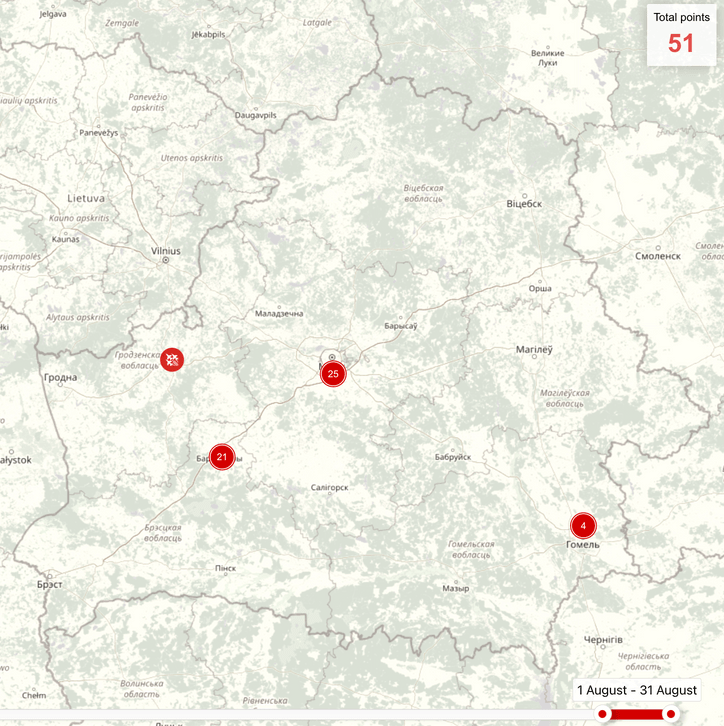
At the same time, military transport and passenger aircraft of the Russian Aerospace Forces and PMC Wagner continued to arrive at the airfields of the Belarusian Armed Forces. The aircraft mentioned above arrived at:
Machulishchy airfield: passenger – 2 business jets linked to Yevgeny Prigozhin (RA-02878 and RA-07893), 1 Tu-154M; transport – 2 An-26, 3 Il-76;
Baranavichy airfield: transport – 3 An-12, 1 An-26, 2 Il-76;
Homiel airport: transport – 2 An-12.
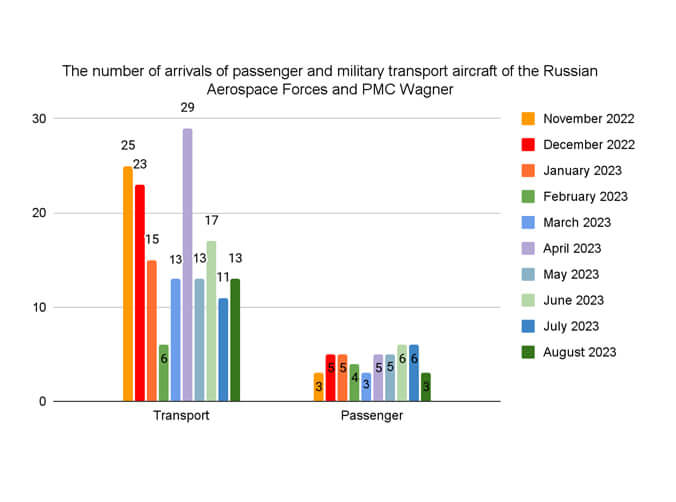
As we can see, the number of arrivals of military transport and passenger aircraft remained almost the same in August compared to July. At the same time, some of the arrivals of transport aircraft were connected with the withdrawal of the group of the Russian Aerospace Forces from Belarus. Some flights were connected with the delivery of military personnel to participate in the CSTO drills. It should also be noted that two of the three arrivals of passenger aircraft were connected with the arrivals of Yevgeny Prigozhin’s planes to Belarus.
During the month, the activity of the Russian Aerospace Forces was also observed at Homiel airport, where two An-12 military transport aircraft arrived. It is possible that these arrivals could be connected with the activity of the Russian military at Ziabrauka airfield (see paragraph 2.3 of the review). The dynamics of arrivals of military transport aircraft of the Russian Aerospace Forces at Homiel airport can be seen in the diagram below.
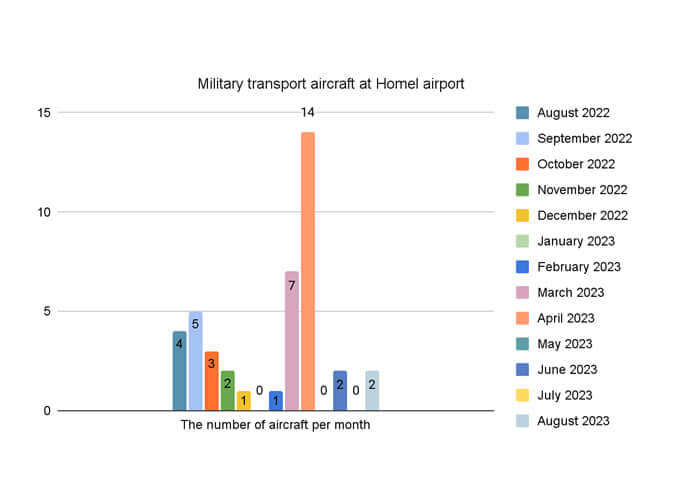
Separately, we should mention the missile attack, which was allegedly recorded on August 5 from the territory of Belarus. The information about the strike could not be initially confirmed. Later, a representative of the Ukrainian Air Force denied the fact of the missile launch from the territory of Belarus. It is possible that the missile, launched by the Russian Aerospace Forces, could have crossed the airspace of Belarus. It should be noted that the last known missile strike from the territory of Belarus was launched by the Russian Aerospace Forces on October 6, 2022.
3. Private military company Wagner
According to our estimates, there could be 4000-4500 mercenaries of PMC Wagner in Belarus as of mid-August. At the moment, it is difficult to provide more precise estimates due to:
- information about part of the mercenaries leaving Belarus for Russia;
- partial dismantling of the field camp in Tsel village.
During the first half of August, information about the mass departure of mercenaries of PMC Wagner from Belarus to Russia for vacation was actively spread. Among the reasons for the departure of the mercenaries was the reluctance of the Lukashenko regime to participate in the financing of the PMC, as they believed that the funding would come from Russia. However, this version was not confirmed. There was also information about the transfer of mercenaries from Belarus to Africa to participate in hostilities there. However, no flights with mercenaries from Belarus to Africa were recorded. We also note that one convoy with equipment of PMC Wagner, which arrived in Belarus (15 vehicles and about 70 mercenaries), was recorded during the month.
The main deployment location of the mercenaries is still the camp in Tsel village, Asipovichy district. According to satellite images of July 31, the mercenaries of PMC Wagner were setting up a field camp in the forest area at the Asipovichski training ground, several kilometers away from the camp in Tsel village. There was construction of dugouts. It should be noted that the dugouts were equipped with stoves, which may indicate that they were preparing for winter. Later construction was explained by the equipment of a safer and more hidden place of accommodation for the mercenaries. This also explained the partial dismantling of the camp in Tsel village.
According to satellite images of August 23, 101 out of 273 tents in the camp, or ⅓ of the field camp, were dismantled. This means that the capacity of the camp has been reduced by almost 2000 people (20 people per tent). The dismantling of the tents reportedly began no later than July 25 and lasted throughout August. At the same time, the number of vehicles at the camp didn’t change. In fact, the information about the dismantling of part of the mercenaries’ field camp is the only confirmation that part of the mercenaries could actually leave Belarus in the first half of August. Later, the information about the dismantling of part of the tents and the departure of the mercenaries was confirmed by Lukashenko.
Given the recent events (the death of Yevgeny Prigozhin), the fate of the mercenaries and their camp in Belarus is unclear. Despite the dismantling of part of the tents, the number of vehicles at the camp in Tsel village remains almost the same. In other words, if part of the mercenaries did return to Russia, PMC Wagner in general was not going to completely shut down its field camp. This hypothesis is confirmed by the registration of two companies linked to Yevgeny Prigozhin. The last of them was registered on August 4.
During the month, several informational provocations related to the alleged presence of PMC Wagner mercenaries in the border areas with Lithuania and Poland were detected. These provocations were part of the PSYOP.
No active movements of the mercenaries of PMC Wagner on the territory of Belarus were recorded.
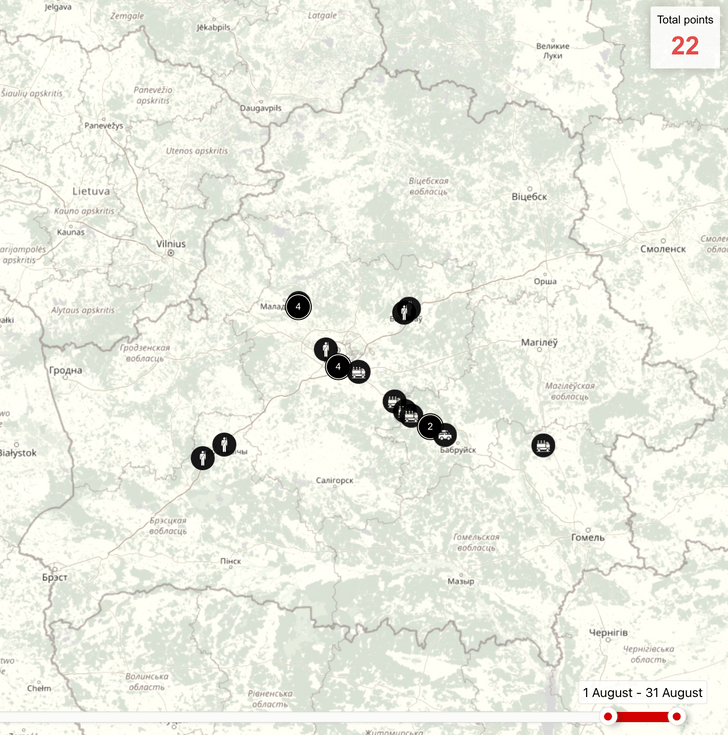
4. General conclusions.
1. During the month, the Belarusian Armed Forces functioned as usual. Combat training activities were seasonal and scheduled.
It is worth noting that some normative acts on the issues of military training sessions and seizure of vehicles in case of mobilization have been updated (see paragraph 1.6 of the review). This shows that the Ministry of Defense of Belarus is seeking to keep legal acts up-to-date and to amend them in accordance with the current situation.
The ongoing rearmament of the Belarusian Armed Forces in various areas (aviation equipment, air defense and communications equipment, MLRS, etc.) should also be noted.
2. The Russian Armed Forces completely withdrew the units that were part of the regional group of troops from the territory of Belarus. The purpose that was set before the deployment of the egional group of troops (training of the mobilized Russians at training grounds in Belarus) seems to have been achieved. Russia has enough capacity to provide training for recruits. For these purposes, the territory of Belarus is not needed yet. It is possible that in case a new wave of mobilization in Russia is announced, the training of the Russian military may be resumed in Belarus.
For this reason, the Russian Armed Forces can again redeploy their units to Belarus at any time. In this regard, we should pay special attention to the CSTO drills, since after their completion, units of the Russian Armed Forces may in theory not be withdrawn from the territory of Belarus.
In general, the tasks to destabilize the situation on the borders of Belarus with Ukraine and NATO member states are performed by the mercenaries of PMC Wagner.
Currently, two military bases of the Air Defense Forces are deployed in Belarus (at Mazyr (Bokau) and Ziabrauka airfields), and military facilities (Baranavichy radar station and the Russian Navy’s 43rd communication center in Vileika).
3. Due to the death of Yevgeny Prigozhin, the mercenaries of PMC Wagner can expect a transformation of their activities. Right now we may assume the following options for the development of the situation:
- Complete shutdown of the mercenaries’ activity (so far an unlikely scenario);
- The infrastructure of PMC Wagner will continue to work under new management (perhaps in some new format);
- The transfer of the structure of PMC Wagner under control of the Lukashenko regime (an unlikely scenario, because, for example, there may not be enough resources to keep the mercenaries, and for a number of other reasons).
So far, it is difficult to make long-term forecasts due to the insufficient amount of information and the dynamically changing situation.
As noted above, PMC Wagner has taken over from the regional group of troops of the Russian Armed Forces the task of creating tension primarily with NATO countries bordering Belarus. It should be noted that this is facilitated by a number of informational provocations and PSYOPs.
